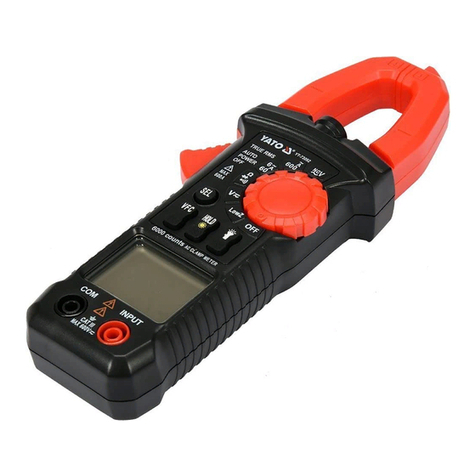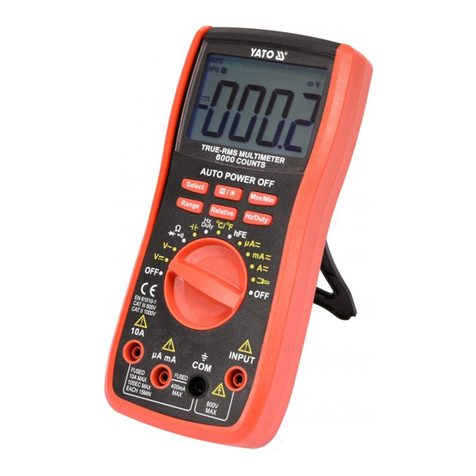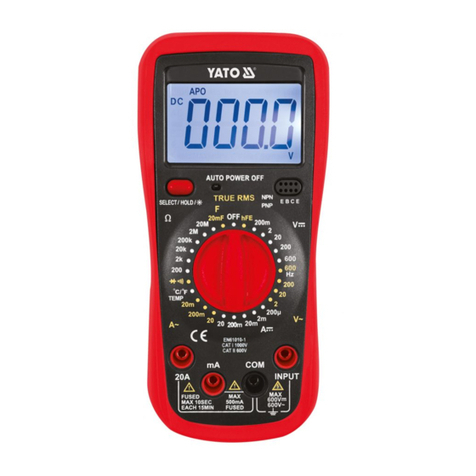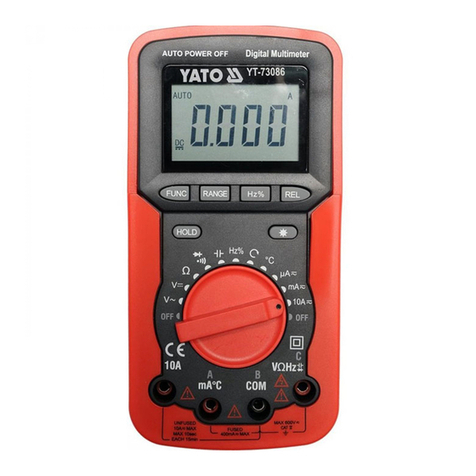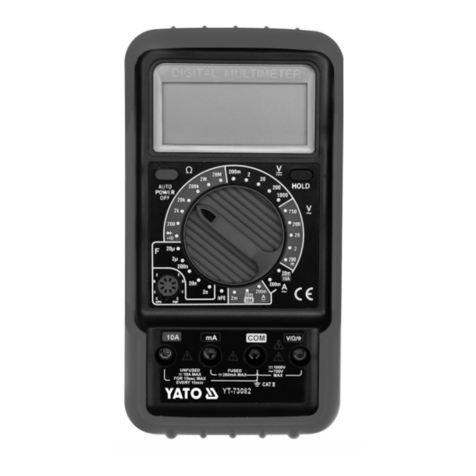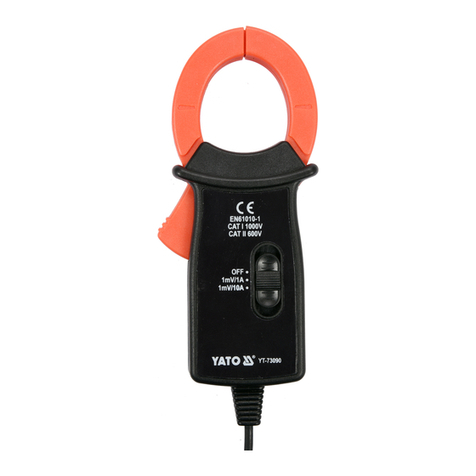YATO YT-73088 User manual

INSTRUKCJA OBSŁUGI 1
PL
DE
RUS
LV
HU
E
RO
CZ
UA
LT
SK
MULTIMETR CYFROWY
DIGITAL MULTIMETER
DIGITALES MULTIMETER
ЦИФРОВОЙ МУЛЬТИМЕТР
ЦИФРОВИЙ МУЛЬТИМЕТР
SKAITMENINIS MULTIMETRAS
CIPARU MULTI-MĒRĪTĀJS
DIGITÁLNÍ MULTIMETR
DIGITÁLNY MULTIMETER
DIGITÁLIS MULTIMÉTER
APART DIGITAL DE MASURAT
MULTIMETRO DIGITAL
YT-73088
GB

INSTRUKCJA OBSŁUGI
2
DE
1. miernik
2. ekran
3. wybierak
4. przyciski sterujce
5. przycza miernika
6. kable pomiarowe
1. meter
2. display
3. selector
4. control buttons
5. connections of the meter
6. measurement leads
1.
2.
3.
4.
5.
6.
1. matuoklis
2. ekranas
3. parinkties perjungiklis
4. valdymo mygtukai
5. matuoklio lizdai
6. matavimo laidai
1.
2.
3.
4.
5.
6.
1. mrtjs
2. ekrns
3. prsldzjs
4. vadbas pogas
5. mrtja kontakti
6. mršanas vadi
1. mící pístroj
2. displej
3. pepína
4. ovládací tlaítka
5. zdíky mícího pístroje
6. mící vodie
1. merací prístroj
2. displej
3. prepína
4. ovládacie tlaidlá
5. zdierky meracieho prístroja
6. meracie vodie
1. mérmszer
2. kijelz
3. választó kapcsoló
4. vezérlgombok
5. a mérmszer csatlakozói
6. mérkábelek
1. aparat de msurat
2. ecran
3. buton de selectare
4. butoane de control
5. conexiuni aparat de msurat
6. conductori de msurat
1. medidor
2. pantalla
3. selector
4. botones de control
5. conexiones del medidor
6. cables de medición
EROHUSK
CZ
LV
UA LT
RUS
GB
PL
1. Messgerät
2. Bildschirm
3. Wählschalter
4. Steuertasten
5. Anschlüsse des Messgerätes
6. Messkabel
TOYA S.A. ul. Sotysowicka 13-15, 51-168 Wrocaw, Polska
Rok produkcji:
Production year: Produktionsjahr:
: :
Pagaminimo metai:
2012 Ražošanas gads:
Rok výroby: Rok výroby:
Gyártási év: Anul produciei utilajului:
Año de fabricación:
PL DE RUS LV HU EROCZUA LT SKGB
6
1
2
3
4
5

INSTRUKCJA OBSŁUGI 3
OCHRONA ŚRODOWISKA
Symbol wskazujcy na selektywne zbieranie zuytego sprztu elektrycznego i elektronicznego. Zuyte urzdzenia elektryczne ssurowcami wtórnymi - nie wolno wyrzucaich do
pojemników na odpady domowe, poniewazawierajsubstancje niebezpieczne dla zdrowia ludzkiego i rodowiska! Prosimy o aktywnpomoc w oszczdnym gospodarowaniu zasobami
naturalnymi i ochronie rodowiska naturalnego przez przekazanie zuytego urzdzenia do punktu skadowania zuytych urzdzeelektrycznych. Aby ograniczyilo usuwanych odpadów
konieczne jest ich ponowne uycie, recykling lub odzysk w innej formie.
UMWELTSCHUTZ
Das Symbol verweist auf ein getrenntes Sammeln von verschlissenen elektrischen und elektronischen Ausrüstungen. Die verbrauchten elektrischen Geräte sind Sekundärrohstoffe – sie
dürfen nicht in die Abfallbehälter für Haushalte geworfen werden, da sie gesundheits- und umweltschädigende Substanzen enthalten! Wir bitten um aktive Hilfe beim sparsamen Umgang
mit Naturressourcen und dem Umweltschutz, in dem die verbrauchten Geräte zu einer Annahmestelle für solche elektrischen Geräte gebracht werden. Um die Menge der zu beseitigenden
Abfälle zu begrenzen, ist ihr erneuter Gebrauch, Recycling oder Wiedergewinnung in anderer Form notwendig.
ОХРАНА ОКРУЖАЮЩЕЙ СРЕДЫ
. – ,
, , !
. , ,
.
ОХОРОНА НАВКОЛИШНЬОГО СЕРЕДОВИЩА
. ,
, , !
, . , , ,
.
APLINKOS APSAUGA
Simbolis nurodo, kad suvartoti elektroniniai ir elektriniai renginiai turi bti selektyviai surenkami. Suvartoti elektriniai rankiai, – tai antrins žaliavos – jnegalima išmesti namkio
atliekkonteiner, kadangi savo sudtyje turi medžiagpavojingžmgaus sveikatai ir aplinkai! Kvieiame aktyviai bendradarbiauti ekonomiškame natraliišteklitvarkyme perduodant
netinkamvartoti ranksuvartotelektros renginisurinkimo punkt. Šalinamatliekkiekiui apriboti yra btinas jpakartotinis panaudojimas, reciklingas arba medžiagatgavimas
kitoje perdirbtoje formoje.
VIDES AIZSARDZĪBA
Simbols rda izlietoto elektrisko un elektronisko iekrtu selektvu savkšanu, Izlietotas elektriskas iekrtas ir otrreizjas izejvielas – nevar bt izmestas ar mjsaimniecbas atkritumiem, jo
satur substances, bstamas cilvku veselbai un videi! Ldzam aktvi paldzt saglabt dabisku bagtbu un sargt vdi, pasniegšot izlietoto iekrtu izlietotas elektriskas ierces savkšanas
punkt. Lai ierobežot atkritumu daudzumu, tiem jbt vlreiz izlietotiem, prstrdtiem vai dabtiem atpakacitform.
OCHRANA ŽIVOTNÍHO PROSTŘEDÍ
Symbol poukazuje na nutnost separovaného sbru opotebovaných elektrických a elektronických zaízení. Opotebovaná elektrická zaízení jsou zdrojem druhotných surovin – je zakázáno
vyhazovat je do nádob na komunální odpad, jelikož obsahují látky nebezpené lidskému zdraví a životnímu prostedí! Prosíme o aktivní pomoc pi úsporném hospodaení s pírodními zdroji
a ochranživotního prostedí tím, že odevzdáte použité zaízení do sbrného stediska použitých elektrických zaízení. Aby se omezilo množství odpad, je nevyhnutné jejich optovné
využití, recyklace nebo jiná forma regenerace.
OCHRANA ŽIVOTNÉHO PROSTREDIA
Symbol poukazuje na nutnosseparovaného zberu opotrebovaných elektrických a elektronických zariadení. Opotrebované elektrické zariadenia sú zdrojom druhotných surovín – je
zakázané vyhadzovaich do kontejnerov na komunálny odpad, nakoko obsahujú látky nebezpené udskému zdraviu a životnému prostrediu! Prosíme o aktívnu pomoc pri hospodárení
s prírodnými zdrojmi a pri ochrane životného prostredia tým, že opotrebované zariadenia odovzdáte do zberného strediska opotrebovaných elektrických zariadení. Aby sa obmedzilo
množstvo odpadov, je nutné ich opätovné využitie, recyklácia alebo iné formy regenerácie.
KÖRNYEZETVÉDELEM
A használt elektromos és elektronikus eszközök szelektív gyjtésére vonatkozó jelzés: A használt elektromos berendezések újrafelhasználható nyersanyagok – nem szabad ket a háztar-
tási hulladékokkal kidobni, mivel az emberi egészségre és a környezetre veszélyes anyagokat tartalmaznak! Kérjük, hogy aktívan segítse a természeti forrásokkal való aktív gazdálkodást
az elhasznált berendezéseknek a tönkrement elektromos berendezéseket gyjtpontra történbeszállításával. Ahhoz, hogy a megsemmisítendhulladékok mennyiségének csökkentése
érdekében szükséges a berendezések ismételt vagy újra felhasználása, illetve azoknak más formában történvisszanyerése.
PROTEJAREA MEDIULUI
Simbolul adunrii selective a utilajelor electrice i electronice. Utilajele electrice uzate sunt materie primrepetat– este interzisaruncarea lor la gunoi, deoarece conin substane
duntoare sntii omeneti cât duntoare mediului! Vrugm deci savei o atitudine activîn ceace privete gospodrirea economica resurselor naturale i protejarea mediului
natural prin predarea utilajului uzat la punctul care se ocupde asemenea utilaje electrice uzate. Pentru a limita cantitile deeurilor eliminate este necesarîntrebuinatrea lor din nou ,
prin recyklind sau recuperarea în altform.
PROTECCIÓN DEL MEDIO AMBIENTE
El símbolo que indica la recolección selectiva de los aparatos eléctricos y electrónicos usados. ¡Aparatos eléctricos y electrónicos usados son reciclados – se prohíbe tirarlos en contene-
dores de desechos domésticos, ya que contienen sustancias peligrosas para la salud humana y para el medio ambiente! Les pedimos su participación en la tarea de la protección y de los
recursos naturales y del medio ambiente, llevando los aparatos usados a los puntos de almacenamiento de aparatos eléctricos usados. Con el fin de reducir la cantidad de los desechos,
es menester utilizarlos de nuevo, reciclarlos o recuperarlos de otra manera.
ENVIRONMENTAL PROTECTION
Correct disposal of this product: This marking shown on the product and its literature indicates this kind of product mustn’t be disposed with household wastes at the end of its working
life in order to prevent possible harm to the environment or human health. Therefore the customers is invited to supply to the correct disposal, differentiating this product from other types
of refusals and recycle it in responsible way, in order to re - use this components. The customer therefore is invited to contact the local supplier office for the relative information to the
differentiated collection and the recycling of this type of product.
PL DE RUS LV HU EROCZUA LT SKGB

INSTRUKCJA OBSŁUGI
4
Napicie stae
Direct voltage
Gleichspannung
Nuolatini tampa
Nemaingais spriegums
Naptí stejnosmrné
Napätie jednosmerné
Egyenfeszültség
Tensiune de curent contnuu
Tensiones constantes
Napicie przemienne
Alternating voltage
Wechselspannung
Kintamoji tampa
Maispriegums
Naptí stídavé
Napätie striedavé
Váltakozó feszültség
Tensiune de curent alternativ
Tensiones alternantes
Prd stay
Direct current
Gleichstrom
Nuolatini tampa
Ldzstrva
Proud stejnosmrný
Prúd jednosmerný
Egyenáram
Curent contnuu
Corriente directa
Prd przemienny
Alternating current
Wechselstrom
Kintamoji tampa
Maistrva
Proud stídavý
Prúd striedavý
Váltóáram
Curent alternativ
Corriente alterna
Rezystancja
Resistance
Widerstand
Varža
Rezistence
Odpor
Odpor
Ellenállás
Rezisten omic
Resistencia
Pojemno
Capacity
Kapazität
Talpa
Tilpums
Kapacita
Kapacita
Kapacitás
Capacitatea
Capacidad
PL DE RUS LV HU EROCZUA LT SKGB
U
D.C.
0-600V
I
D.C.
0-10A
U
A.C.
0-600V
I
A.C.
0-10A
R
0-60
M Ω
C
0-4000
μF
Kontrola diod
Diode tests
Diodenkontrolle
Diodkontrol
Diodes prbaude
Kontrola diod
Kontrola diód
Diódaellenrzés
Verificarea diodelor
Control de diodos
Temperatura
Temperature
Temperatur
Temperatra
Temperatra
Teplota
Teplota
Hmérséklet
Temperatura
Temperatura
wbudowany brzczyk
built-in buzzer
eingebaute Summer
taisytas zirzeklis
iebvts signalizators
zabudovaný bzuák
zabudovaný bzuák
beépített berreg
semnal fonic
alarma integrada
T
-20
O
÷
+1000
O
C
Czstotliwo
Frequency
Frequenz
Dažnis
Frekvence
Frekvence
Frekvencia
Frekvencia
Frecvena
Frecuencia
f
9,999MHz
max
Wspóczynnik wypenienia
Pulse-duty factor
Einschaltdauer
Impulso laiko ir signalo trukms santykis
Samra koeficients
initel plnní (stída)
initeplnenia (strieda)
Kitöltési tényez
Raport ciclic
Factor de duración del impulso
5% ÷95%
True
RMS
Pomiar rzeczywistej wartoci skutecznej sygnau
Measurement of the root square value of the signal
Die Messung der quadratische Wert des Signals
Matavimo signalo root kvadratinreikšm
Mršana saku eometriskvrtba signla
Mení hodnoty koene námstí signálu
Meranie hodnoty korea námestí signálu
Mérése a root tér értékét a jel
De msurare a valorii rdcina ptrata semnalului
Medición del valor de la raíz cuadrada de la señal

INSTRUKCJA OBSŁUGI 5
PLPL
CHARAKTERYSTYKA PRZYRZĄDU
Miernik wielofunkcyjny jest cyfrowym przyrzdem pomiarowym przeznaczonym do wykonywania pomiarów rónych wielkoci elek-
trycznych. W przypadku niektórych wielkoci pomiarowych miernik potrafi sam dobrazakres w zalenoci od wyniku pomiaru. Miernik
mierzy rzeczywistwarto skutecznsygnaów okresowo zmiennych (true RMS), co pozwala na dokadne okrelenie tej wartoci,
równiedla sygnaów o przebiegu innym nisinusoidalny.
Przed rozpoczęciem pracy miernikiem należy przeczytaćcałą instrukcjęi zachowaćją.
Miernik posiada obudowz tworzywa sztucznego, wywietlacz ciekokrystaliczny, przecznik zakresów pomiarowych. W obudowie
zainstalowane sgniazda pomiarowe oraz gniazdo do sprawdzania tranzystorów. Miernik wyposaony jest w przewody pomiarowe
zakoczone wtykami. Miernik sprzedawany jest bez baterii zasilajcej.
UWAGA! Oferowany miernik nie jest przyrzdem pomiarowym w rozumieniu ustawy „Prawo o pomiarach”
DANE TECHNICZNE
Wywietlacz: LCD 4 cyfry - maksymalny wywietlany wynik: 9999
Czstotliwo próbkowania: okoo
3 razy na sekund
Oznakowanie przecienia: wywietlany symbol „OL”
Oznakowanie polaryzacji: wywietlany znak „-” przed wynikiem pomiaru
Bateria: 6F22; 9 V
Temperatura pracy: 0 ÷ 40 st. C; przy wzgldnej wilgotnoci <75%
Temperatura przechowywania: -10 st. C ÷ +50 st. C; przy wzgldnej wilgotnoci <85%
Wymiary zewntrzne: 185 x 86 x 44 mm
Waga: ok. 380 g
UWAGA! Zabronione jest mierzenie wartości elektrycznych przekraczających maksymalny zakres pomiarowy miernika.
Parametr
Napicie stae Napicie przemienne Prd stayPrd przemienny
dla zakresu 600 mV: RIN > 1000 M;
pozostae zakresy: RIN = 10 MRIN = 10 M; fIN = 40 ÷ 1000 Hz UAB 400 mV fIN = 40 ÷ 400Hz
Nr. katalogowy Zakres Rozdzielczo Dokadno Zakres Rozdzielczo Dokadno Zakres Rozdzielczo Dokadno Zakres Rozdzielczo Dokadno
YT-73088
600 mV 0,1 mV ±(0,8% + 5) 6 V 0,1 mV ±(1,6% + 10) 600 A 0,1 A
±(1,0% + 7)
600 A 0,1 A
±(1,8% + 10)
6 V 1 mV ±(0,5% + 5) 60 V 1 mV
±(1,5% + 10)
6000 A1A 6000 A1A
60 V 10 mV ±(0,8% + 5)
600 V 10 mV
60 mA 0,01 mA 60 mA 0,01 mA
600 V 0,1 V ±(1,0% + 7)
600 mA 0,1 mA 600 mA 0,1 mA
6A 0,001 A ±(1,5% + 7) 6A 0,001 A ±(2,5% + 10)
10 A 0,01 A 10 A 0,01 A
Uwagi Zabezpieczenie przecieniowe:
zakres 400 mV: 250 V; pozostae
zakresy: 600 V Zabezpieczenie przecieniowe: 600 V Zabezpieczenie przecieniowe: bezpiecznik 630 mA/690 V, szybki; zakres 10
A: 10A/690V, szybki - pomiar prdu > 2A , czas pomiaru < 10 sek. w interwaach
> 15 min.
Parametr Rezystancja Pojemno (pomiar relatywny) Czstotliwo Kontrola diod
Nr. katalogowy Zakres Rozdzielczo Dokadno Zakres Rozdzielczo Dokadno Zakres Rozdzielczo Dokadno Warunki pomiaru
YT-73088
600 0,1 ±(1,0% + 5) 40 nF 0,01 nF ±(3,5% + 20) 9,999 Hz 0,001 Hz
±(1,0% + 5) IF= 0,8 mA UR= 3 V
6 k1
±(0,8% + 5)
400 nF 0,1 nF ±(2,5% + 5) 99,99 Hz 0,01 Hz
60 k10 4 F 0,001 F ±(3,5% + 5) 999,9 Hz 0,1 Hz
600 k0,1 k40 F 0,01 F ±(4,0% + 5) 9,999 kHz 0,001 kHz
6 M1 k±(1,5% + 5) 400 F 0,1 F ±(5,0% + 5) 99,99 kHz 0,01 kHz
60 M10 k±(3,0% + 10) 4000 F1F nie okrelono 999,9 kHz 0,1 kHz
9,999 MHz 1 kHz nie okrelono
Uwagi Napicie obwodu otwartego okoo 0,25 V; Za-
bezpieczenie przecieniowe 250 V d.c./a.c.
Dokadno nie uwzgldnia bdu
spowodowanego pojemnocimiernika i
przewodów pomiarowych. Dla zakresów
400 nF naley od wyniku odj pojem-
no miernika i przewodów pomiarowych
Zakres napi sygnau wejciowego: 1 V rms
÷ 20 V rms; stosowaautomatyczny dobór
zakresu pomiarowego
Table of contents
Languages:
Other YATO Multimeter manuals
